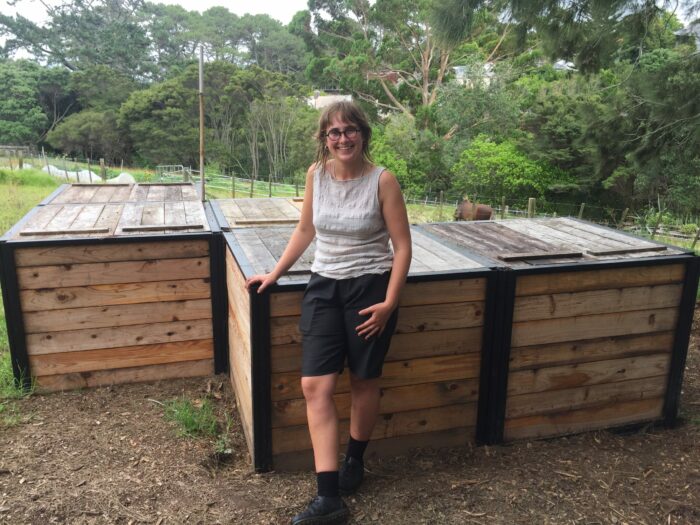Waste not, want not

Meet the Auckland social enterprise diverting household food scraps from landfill and generating community garden gold. Words: Gretchen Carroll
Every Friday, Madeleine Cull hops on an e-bike with a trailer and collects buckets of scraps from the pickup areas of Grey Lynn, Ponsonby and Herne Bay.
She’ll collect food scraps from both residential and business customers to deliver to Soil Factory, a social enterprise that’s part of Auckland’s Kelmarna Gardens.
Following permaculture principles, the 40-year-old community garden has market garden produce at its centre, surrounded by a food forest and, on the outside, livestock. Overall, Kelmarna Gardens is moving into a regenerative gardening and farming space. The Soil Factory component was kicked off in 2019 by Andy Boor, the Gardens’ General Manager. At the time, Madeleine was a volunteer – and when Andy saw how passionate she was about the work, Madeleine became Soil Factory Coordinator in a paid role.
“I’m proud of the compost, it’s been two years’ hard work,” says Madeleine. “If everyone had home compost that would be fantastic, but it can be difficult if you’re a busy household or live in an apartment.”

They currently have 73 customers, made up of 68 households and five businesses – Annabel’s Wine Bar, Ecoware, Clover Ferments, Ozone Coffee and The Village. Residential customers can also drop off their scraps any time and most do this as they live locally and it costs less.
The resulting compost is used in the Gardens, and to date they have needed it all. Compost is currently being used to develop a new market garden area, and once this is established, excess compost will be sold to the local community.
Madeleine has one highly trained volunteer who works with her, and a turnover of casual volunteers who help out.
“The great thing is volunteers learn how to compost properly, and then they go off and do composting at their own home.”
Community compost hubs are popping up around Aotearoa. Soil Factory was inspired by Wellington’s
Kaicycle, which has been operating since 2012, and Madeleine says there are about four to five hubs
operating in Auckland, who run off a similar model.
“It’s satisfying making something out of what otherwise would be waste – grow food from it, build a community and create food sovereignty,” she says.
Soil Factory uses the CarbonCycle Composting System, comprised of large wooden boxes. They are
expensive but hard-wearing, strong and made in New Zealand. The bins contain compost at different
stages, and their temperature is taken to gauge where the compost is at. Madeleine says beneficial
microbes exist at 55–65°C, so if the compost’s temperature is either too high or too low they
adjust it by turning it, adding or reducing nitrogen (the food scraps), or adding carbon (the browns).
“Temperature’s the most important factor in hot composting as you’re essentially working in the
dark, and temperature’s an indicator.”
Soil Factory is looking for more business customers, as they bring in more dollars to fund
Kelmarna’s work to connect people with food growing and soil health. It is also keen to service
businesses that aren’t going to be included in Auckland Council’s plans for kerbside collection of
food scraps, due to start 2023.
Currently, Soil Factory estimates between 30 and 50 per cent of what Auckland sends to landfill
from kerbside collection is food scraps. When organic material is buried in landfill, it breaks down
anaerobically (without oxygen), producing harmful methane emissions and toxic leachate.
The Council’s planned scheme will process food scraps at an anaerobic digestion plant in Reporoa
that turns it into renewable energy. While you could argue this is better than food scraps going
direct to landfill, Madeleine is worried this kerbside collection will shift people’s attention
away from reducing waste or home composting. Also, that carbon won’t be collected, only food
scraps.

It’s helpful, she advises, to think of food waste as a pyramid. At the top is the best option, which
is to avoid making food waste in the first place; then comes home composting because the
person is directly engaged with the process; next down is community composting, which keeps it
local; then large-scale collection of food scraps from households for anaerobic digestion; and the
last and worst option is sending scraps to landfill.
Madeleine encourages people to get involved in composting however they can, whether at home
or at a community garden. “I enjoy how you can see life and death in compost!”
Madeleine’s three main composting tips
• Aeration – make sure to stir the compost, or have a compost turner, as you want high temperatures. Remember, good compost should smell like a forest floor.
• Include carbon – make sure to add leaves, mulch and cardboard tubes.
• Be curious – try to see composting not as a chore but a beautiful thing.
